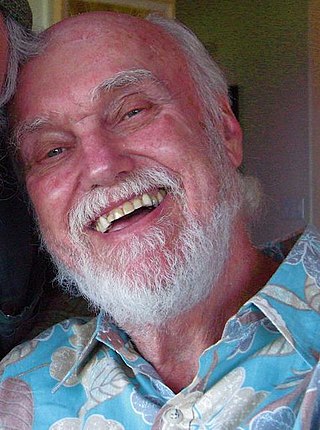
Ram Dass, also known as Baba Ram Dass, was an American spiritual teacher, guru of modern yoga, psychologist, and writer. His best-selling 1971 book Be Here Now, which has been described by multiple reviewers as "seminal", helped popularize Eastern spirituality and yoga in the West. He authored or co-authored twelve more books on spirituality over the next four decades, including Grist for the Mill (1977), How Can I Help? (1985), and Polishing the Mirror (2013).

Neem Karoli Baba or Neeb Karori Baba, also known to his followers as 'Maharaj-ji', was a Hindu guru and a devotee of the Hindu deity Hanuman. He is known outside India for being the spiritual master of a number of Americans who travelled to India in the 1960s and 1970s.

Muktananda, born Krishna Rai, was a yoga guru and the founder of Siddha Yoga. He was a disciple of Bhagavan Nityananda. He wrote books on the subjects of Kundalini Shakti, Vedanta, and Kashmir Shaivism, including a spiritual autobiography entitled The Play of Consciousness. In honorific style, he is often referred to as Swami Muktananda, or Baba Muktananda, or in a familiar way just Baba.
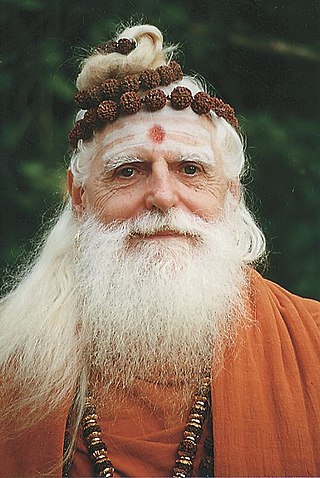
Sivaya Subramuniyaswami was an American Hindu religious leader known as Gurudeva by his followers. Subramuniyaswami was born in Oakland, California and adopted Hinduism as a young man. He was the 162nd head of the self claimed Nandinatha Sampradaya's Kailasa Parampara and Guru at Kauai's Hindu Monastery which is a 382-acre (155 ha) temple-monastery complex on Hawaii's Garden Island.

Siddha Yoga is a spiritual path founded by Swami Muktananda (1908–1982). According to its literature, the Siddha Yoga tradition is "based mainly on eastern philosophies" and "draws many of its teachings from the Indian yogic texts of Vedanta and Kashmir Shaivism, the Bhagavad Gita and the poet-saints." The present head of Siddha Yoga is Gurumayi Chidvilasananda.

Dattatreya, Dattā or Dattaguru, is a paradigmatic Sannyasi (monk) and one of the lords of yoga, venerated as a Hindu god. He is considered to be an avatar and combined form of the three Hindu gods Brahma, Vishnu, and Shiva, who are also collectively known as the Trimurti, and as the manifestation of Parabrahma, the supreme being, in texts such as the Bhagavata Purana, the Markandeya Purana, and the Brahmanda Purana, though stories about his birth and origin vary from text to text. Several Upanishads are dedicated to him, as are texts of the Vedanta-Yoga tradition in Hinduism. One of the most important texts of Hinduism, namely Avadhuta Gita is attributed to Dattatreya. Over time, Dattatreya has inspired many monastic movements in Shaivism, Vaishnavism, and Shaktism, particularly in the Deccan region of India, Maharashtra, Gujarat, Madhya Pradesh, Rajasthan and Himalayan regions where Shaivism is prevalent. His pursuit of simple life, kindness to all, sharing of his knowledge and the meaning of life during his travels is reverentially mentioned in the poems by Tukaram, a saint-poet of the Bhakti movement.
Nandinatha Sampradaya is a denomination of Shaivism sect of Hinduism that places great importance on the practice of yoga. It is related to the broader Nath Sampradaya. The self-styled living preceptor and 163rd head of the Nandinatha Sampradaya's Kailasa Parampara is Bodhinatha Veylanswami. It is most popular among diasporic Hindu communities of North America and beyond, as well among the Sri Lankan Tamils.

Ayyappan Pillai, better known as Chattampi Swamikal was a Hindu sage and social reformer whose thoughts and work influenced the launching of many social, religious, literary and political organisations and movements in Kerala and gave voice to those who were marginalised.
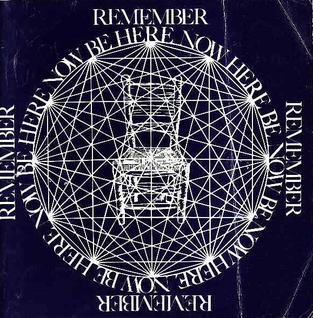
Be Here Now, or Remember, Be Here Now, is a 1971 book on spirituality, yoga, and meditation by the American yogi and spiritual teacher Ram Dass. The core book was first printed in 1970 as From Bindu to Ojas and its title since 1971 comes from a statement his guide, Bhagavan Das, made during Ram Dass's journeys in India. The cover features a mandala incorporating the title, a chair, radial lines, and the word "Remember" repeated four times.
Gurumayi Chidvilasananda, born Malti Shetty on 24 June 1955, is the guru or spiritual head of the Siddha Yoga path, with ashrams in India at Ganeshpuri and the Western world, with the headquarters of the SYDA foundation in Fallsburg, New York.

The Aghori are a Hindu monastic order of ascetic Shaivite sadhus based in Uttar Pradesh, India. They are the only surviving sect derived from the Kāpālika tradition, a Tantric, non-Puranic form of Shaivism which originated in Medieval India between the 4th and 8th century CE.

Gorakhnath was a Hindu yogi, mahasiddha and saint who was the founder of the Nath Hindu monastic movement in India. He is considered one of the two disciples of Matsyendranath. His followers are known as Jogi, Gorakhnathi, Darshani or Kanphata.

Guruji Shri Rishi Prabhakar (1948–2014) was an Indian yogi who instructed many spiritual teachers across the country. He was the founder of Rishi Samskruti Vidya Kendra, a Public Charitable Trust. He also developed many programs such as Siddha Samadhi Yoga (SSY), Kaya Kalpa Kriya (KKK), Advanced Meditation Course (AMC), Bhava Samadhi Training (BST), Hundred Percent Memory, Infant Siddha Program (ISP) and Inspirational Leadership in Rural Development (ILRD) for the well-being of humanity.
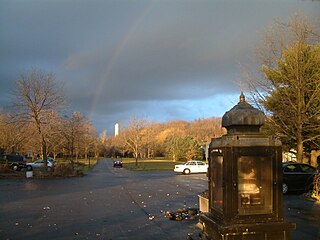
The Rajarajeswari Peetam in Rush, New York is a Sanathana Dharma temple that practices the teachings of Shri Vidya. Sri Chaitanyananda Natha Saraswathi is the peetathipathy of the temple along with his wife Gnanamba (Amma). Aiya is a disciple of Sri Amritananda Natha Saraswathi, the peetathipathy of the Devipuram temple.
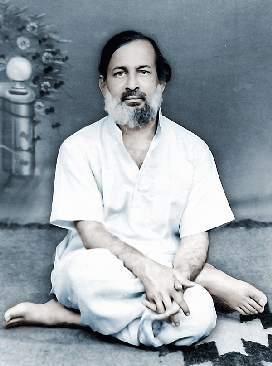
Ekkirala Bharadwaj, was an Indian Dattatreya incarnation and who authored many Hindu spiritual books, primarily on the life and worship of Shirdi Sai Baba and Sri Dattatreya. He is well known as "Sri Sai Master". He had born in the Bharadwajasa gotra like SriPada Swamy. He is the fourth son of Sri Ekkirala Ananthacharya and Srimathi Buchamma. Sri Ekkirala Bharadwaj written Telugu-language book Sri Sai Leelamrutham is one of the famous book. Sri Ekkirala Bharadwaja later translated the book to English with the name Sai Baba The Master which is also a popular one. He also wrote "Sri Guru Charitra" in English and Telugu. He also has written many spiritual books in Telugu and English.
Aghor Yoga also referred to as Aghor is a spiritual tradition that originated in Northern India around the 11th Century C.E. The word Aghor literally means "that which is not difficult or terrible"; according to its adherents, Aghor is a simple and natural state of consciousness, in which there is no experience of fear, hatred, disgust or discrimination. Accordingly, believers contend that any time that humans experience a state of discrimination, we limit our wholeness and fall prey to disruptive emotions such as anger, fear, jealousy, greed, and lust. The practices of Aghor Yoga today reflect reforms made in the 1960s, shifting the focus of Aghor to seeking a balanced life of selfless service and personal practice. Baba Bhagwan Ramji encouraged the practitioners of Aghor to follow the vamachara by embracing socially stigmatized and neglected people, such as street children and people with leprosy and other "untouchable" diseases. Today, the followers of Aghoreshwar Bhagwan Ramji have established a large network of schools, orphanages, medical clinics, or other social service projects.
Thycaud Ayyavu Swamikal was a spiritualist and social reformer. He was the first to challenge caste customs in Kerala during a time when caste restrictions and untouchability were at their peak.
Avdhoot Shivanand Ji is an Indian spiritual leader and founder of ShivYog, an organization that offers meditation programs. He also conducts public discourses which are broadcast on multiple television channels such as Aastha TV, Adhyatm TV and Sanskar TV. He is also involved in various social development activities, which has bestowed him with various honors from communities.

Modern yoga gurus are people widely acknowledged to be gurus of modern yoga in any of its forms, whether religious or not. The role implies being well-known and having a large following; in contrast to the old guru-shishya tradition, the modern guru-follower relationship is not secretive, not exclusive, and does not necessarily involve a tradition. Many such gurus, but not all, teach a form of yoga as exercise; others teach forms which are more devotional or meditational; many teach a combination. Some have been affected by scandals of various kinds.
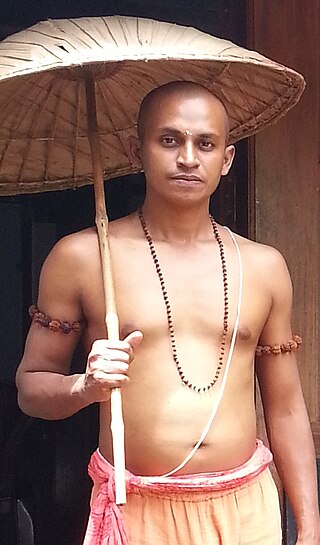
Murugan Chillayah, also known as Guruji Murugan, is a Malaysian Indian of Tamil ancestry who is a teacher of several Indian traditional arts, a yoga guru, and a spiritual leader.
















